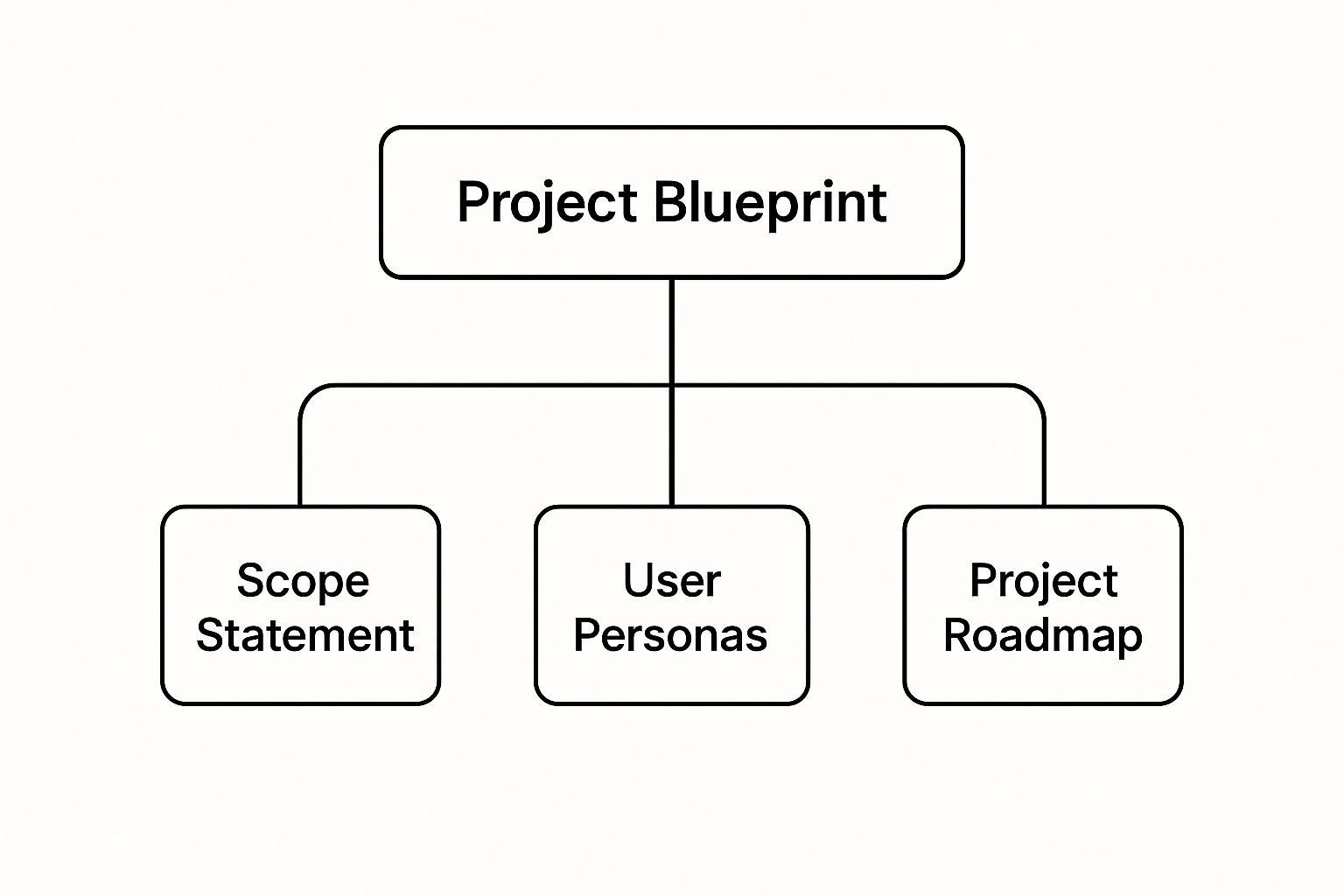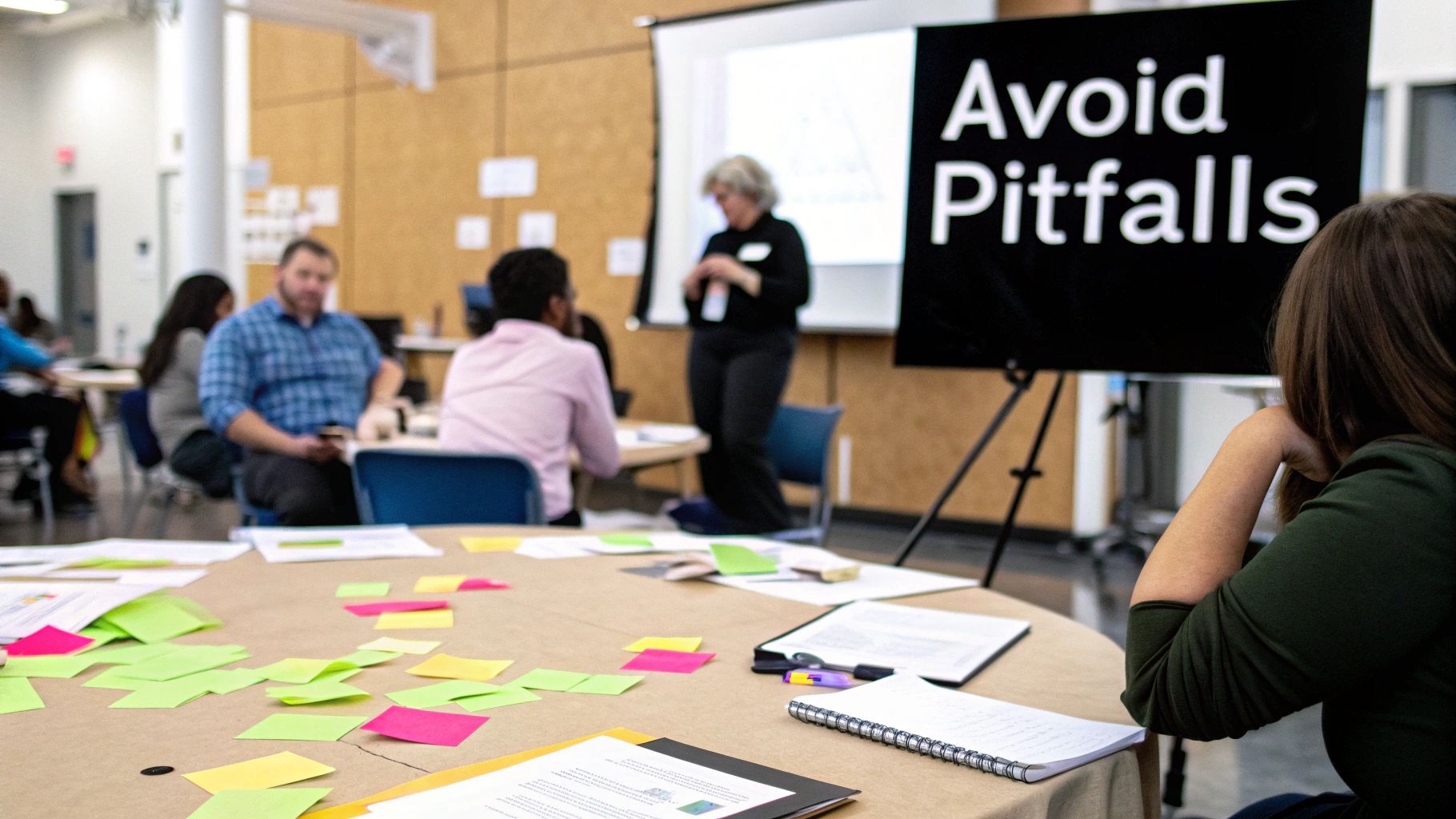Your Guide to Project Phases Discovery
Master project phases discovery to define scope, reduce risks, and ensure success. Learn the steps for a flawless project blueprint before you build.

Imagine trying to build a house without a blueprint. You might have a great idea for a five-bedroom home with a wrap-around porch, but without a solid plan, you’re just guessing. You'll end up with crooked walls, wasted materials, and a final product that’s nowhere near what you envisioned. Kicking off a project without a discovery phase is exactly the same—it's a surefire way to head straight for disaster.
The project discovery phase is that essential blueprinting stage. It's where you pressure-test your ideas, uncover hidden risks, and map out a clear, confident path forward. Skipping it is one of the single biggest predictors of project failure.
Why Skipping Project Discovery Is a Recipe for Failure

Think of project discovery as your ultimate risk-reduction strategy. It’s a structured process for asking the tough questions before you write a single line of code, preventing expensive and painful mistakes down the road. This is where you take a fuzzy concept and sharpen it into a concrete, actionable plan that gets everyone on the same page, locks down the scope, and proves your project is both technically possible and financially smart.
When you ignore this stage, you're essentially gambling with your time, budget, and reputation. Projects that jump straight into development almost always get bogged down by scope creep, confused requirements, and features that nobody actually wants.
The Staggering Cost of Guesswork
Without a proper discovery phase, you’re forced to operate on assumptions instead of facts. You assume you know what your users need. You assume you know which technical roadblocks are waiting for you. You assume you know how long it will all take. And in my experience, those assumptions are almost always wrong.
The fallout from this guesswork can be brutal. It often leads to a cascade of predictable problems:
- Exploding Budgets: Teams burn through cash building the wrong things, which then requires costly rework.
- Blown Deadlines: Unexpected technical hurdles and constantly changing requirements bring progress to a grinding halt.
- Empty User Logs: The finished product doesn't solve a real problem, so it launches to the sound of crickets.
- Burned-Out Teams: A lack of clear direction and constant pivots leaves everyone frustrated and demoralized.
This isn't just a hunch; the numbers tell a stark story. An eye-watering 65% of IT projects worldwide fail to meet their original goals, go over budget, or miss their deadlines. A major reason for this staggering failure rate is the decision to rush past or completely ditch a thorough discovery phase.
Investing time in discovery isn’t adding another step to your project—it’s removing future obstacles. It’s the difference between navigating with a GPS and driving blindfolded.
The difference in outcomes is night and day. Let's look at a side-by-side comparison.
Comparing Outcomes With and Without a Discovery Phase
This table highlights the dramatic contrast between projects that invest in discovery and those that don't. The results speak for themselves.
| Project Aspect | With Discovery Phase | Without Discovery Phase |
|---|---|---|
| Budget | Stays within or close to the original estimate. | Almost always exceeds the budget due to rework and scope creep. |
| Timeline | Realistic and predictable, leading to on-time delivery. | Plagued by delays and missed deadlines. |
| Product-Market Fit | The final product solves a validated user need. | The product is based on assumptions and often misses the mark. |
| Team Morale | High alignment and a clear, shared vision. | Frustration, confusion, and constant changes. |
| Overall Success | High probability of meeting business objectives. | High risk of complete project failure. |
As you can see, the path you choose at the very beginning has a massive impact on your final destination.
Laying a Foundation for Success
At the end of the day, any project's goal is to deliver real value. A well-run discovery phase makes sure you're building the right thing for the right people from the very start. It aligns everyone involved—from the C-suite to the front-line developers—around a single, unified vision.
This alignment is everything. It ensures every decision made throughout the project lifecycle supports the core business goals you uncovered during discovery. By taking the time to understand the complete software product development lifecycle, you can see how discovery sets the stage for every phase that follows. Without it, you're not just risking failure; you're practically planning for it.
Defining Your Project's North Star

The discovery phase isn't just about collecting data. It’s about setting a clear, unwavering direction for the entire project. Think of it as finding your project’s North Star—a fixed point in the sky that keeps everyone oriented and moving together, no matter what challenges come up. This initial step is what turns a fuzzy idea into a concrete, strategic mission.
At its core, discovery is about making sure your business goals actually line up with real-world needs. It’s all too easy to get excited about a brilliant idea, but for a project to succeed, it has to solve a real problem for real people. Discovery is the ultimate reality check, stopping you from pouring resources into a beautiful solution that nobody will ever use.
Validating Your Core Idea
So many projects fail not because of bad code, but because of a bad premise. A team might build a flawless product that, unfortunately, doesn't solve anyone's problem.
Research from CB Insights puts a number on it: 35% of new products fail simply because there’s no market need. That makes a poor product-market fit the single biggest reason for failure. The discovery phase hits this problem head-on by forcing you to test your assumptions with actual research before a single line of code gets written.
The purpose of discovery is to replace "I think" with "I know." It shifts your team’s focus from internal assumptions to external evidence, ensuring you build a product grounded in reality, not wishful thinking.
Defining a Rock-Solid Scope
Once you’ve confirmed the idea is solid, the next step is to draw the lines. A good discovery process produces a crystal-clear picture of your project’s objectives. One of the most important outputs here is a well-defined example of a project scope statement, which basically builds a fence around your project, making it obvious what’s in and what’s out.
This document is your best defense against scope creep—that slow, silent killer of timelines and budgets. By setting firm boundaries early on, you give your team the power to say "no" to distractions and stay laser-focused on delivering what truly matters.
Understanding Your Users Deeply
Finally, the discovery phase is where you build genuine empathy for the people who will actually use your product. You have to get inside their heads and understand their frustrations, motivations, and day-to-day realities. This usually involves creating detailed user personas and mapping out their experiences from start to finish.
To do this right, teams often craft narratives from the user's perspective. You can learn more about this approach in our guide on how to write effective user stories. When you put your users at the very heart of the planning process, you make sure the final product isn’t just functional—it’s genuinely helpful and even enjoyable. And that’s the real measure of success.
How a Discovery Phase Actually Works
So, what does a discovery phase look like in practice? It’s not some theoretical exercise; it’s a hands-on process for turning a rough idea into a concrete, strategic plan. Think of your project team as detectives, piecing together clues to build a strong case for where the project should go.
This is a deeply collaborative stage. The whole point is to get everyone’s unique perspective in one room and move from a bunch of individual assumptions to a shared, evidence-based vision.
Kicking Things Off with Stakeholder Workshops
The heart of any good discovery phase is the stakeholder workshop. These aren't your typical status-update meetings. They are intensive, structured sessions that bring together everyone with a stake in the project—executives, marketers, engineers, customer support, you name it. The goal is to pull out crucial insights, align everyone's expectations, and get buy-in right from the start.
In these workshops, the team works through a series of focused exercises to:
- Define Business Goals: What does a "win" actually look like for us? And how will we measure it?
- Map User Journeys: Who are we building this for, really? What headaches are we trying to solve for them?
- Prioritize Features: What’s a non-negotiable “must-have” versus something that would be “nice to have” later on?
- Identify Risks: What could trip us up down the road, whether it's internal politics or a shift in the market?
Good facilitation is everything here. A skilled project manager makes sure every voice is heard, keeps the conversation from going off the rails, and captures all the decisions. These workshops are where the project’s foundation is poured, and having a solid communication plan ensures everyone stays in sync long after the meeting ends. You can learn more about crafting one with this guide to building an effective project management communication plan.
A successful workshop ends with fewer questions and more clarity. It’s the moment a group of individuals starts functioning as a unified project team with a single, clear objective.
Conducting Essential Research and Analysis
While the workshops are going on, the team is also diving into some serious research. This is the part where you stress-test all those brilliant ideas against cold, hard data.
This analysis usually involves a few key activities:
- Competitor Analysis: We take a hard look at what rivals are doing well and—just as importantly—where their weaknesses are. This is often where you spot untapped opportunities.
- User Interviews: Nothing beats talking directly to your potential customers. This is how you uncover their real-world pain points, needs, and habits.
- Technical Assessment: The team evaluates existing systems, software, and infrastructure to figure out what’s actually possible. This crucial step stops you from promising features that are technically impossible or wildly expensive to build.
All this work ensures the project is grounded in reality, not just wishful thinking. By the time you’re done, you don’t just have a plan; you have a validated, achievable roadmap.
The Blueprint Documents for Your Project
Think of the discovery phase as creating the architectural blueprints for a house. You wouldn't start building without them, right? The same goes for any project. The goal here isn't just to brainstorm; it's to produce a set of clear, practical documents that guide everyone from start to finish.
These documents turn all those great workshop conversations and user interviews into a solid plan. They’re the single source of truth that keeps the entire team on the same page, ensuring the final product is exactly what you envisioned. Without this foundation, you're just inviting confusion, scope creep, and a whole lot of rework down the line.
The infographic below shows how these core documents—like the Scope Statement, User Personas, and Project Roadmap—all come together to support the main project plan.

It’s clear that a strong project needs a mix of strategic, user-focused, and technical documents all working together.
Essential Discovery Deliverables
While every project is a little different, there are a handful of documents that are almost always non-negotiable. These aren't just box-ticking exercises; they are the tools your team will rely on to make smart decisions every single day.
Here’s a look at the usual suspects:
- Project Scope Statement: This is your best defense against scope creep. It draws a clear line in the sand, defining the project's goals, features, and limits. Most importantly, it spells out what's in scope and what's out.
- User Personas and Journey Maps: These documents give your audience a face and a story. Personas are fictional character profiles of your ideal users, and journey maps walk you through their experience, showing you exactly where they get stuck or frustrated.
- Technical Specification Document: This is the playbook for your development team. It details all the technical needs, the architecture, and the tech stack, ensuring they build something that's stable, scalable, and secure.
- Low-Fidelity Wireframes: Think of these as simple, black-and-white sketches of your product's layout. They focus on functionality and user flow—not colors or fonts—making it easy to get early feedback without wasting time on design details.
- Project Roadmap: This is the high-level game plan. It’s a visual timeline that lays out the major project phases and milestones, giving everyone a clear picture of what's coming and when.
One thing to remember: these documents aren't carved in stone. They are living blueprints that will be referenced and tweaked as the project moves forward. But they provide that crucial starting point, grounding every future decision in the original project phases discovery findings.
To keep everything organized and comprehensive, you might find it helpful to start with a solid foundation. You can do this by leveraging technical documentation templates, which help standardize your outputs and make sure nothing gets missed.
The following table breaks down these key deliverables and clarifies the role they play.
Key Discovery Phase Deliverables and Their Purpose
| Deliverable | Primary Purpose | Key Stakeholders |
|---|---|---|
| Project Scope Statement | To define clear project boundaries and prevent scope creep. | Project Manager, Client, Team Leads |
| User Personas | To create empathy and a shared understanding of the target audience. | UX/UI Designers, Marketing, Developers |
| User Journey Maps | To visualize user experiences and identify pain points/opportunities. | UX/UI Designers, Product Managers, Marketers |
| Technical Specs | To guide the development team on how to build the product. | Developers, Tech Leads, QA Engineers |
| Low-Fidelity Wireframes | To map out user flows and information architecture without design distractions. | UX/UI Designers, Product Managers, Developers |
| Project Roadmap | To provide a high-level timeline of major features and milestones. | All Stakeholders, C-Suite, Project Team |
Ultimately, creating these detailed, well-researched documents is what turns ambiguity into a clear path forward. It gives your team the confidence and direction they need to build the right thing, the right way.
Common Mistakes in Project Discovery

Even the most well-intentioned teams can trip up during the discovery phase. Knowing what these common pitfalls look like is the best way to steer clear of them and give your project the solid start it deserves. These mistakes can quietly derail your efforts, turning a great beginning into a source of future headaches.
The biggest mistake? Treating discovery like a box-ticking exercise. Teams that blow through this stage, skimping on time and resources, are basically choosing to build on quicksand. When you rush it, you end up with shallow insights and a pile of unproven assumptions—a perfect recipe for expensive rework down the road.
Ignoring Key Stakeholders
It's a classic blunder: not getting the right people in the room from day one. When you leave out key decision-makers, actual end-users, or department heads, you lose out on their invaluable perspectives. This oversight almost guarantees you'll miss critical requirements, and you'll end up with a product that doesn't actually solve the problem for the business or its customers.
Worse yet, without that early involvement, you don't get their buy-in. Stakeholders who feel like they've been left out are far less likely to champion the project later, creating political roadblocks right when you need momentum.
A project’s success is directly tied to the quality of its foundation. Skipping steps in the project phases discovery process doesn't save time; it just postpones the inevitable problems, making them more expensive to fix.
Relying on Assumptions Instead of Research
Here’s another all-too-common trap: running with internal assumptions instead of doing the research. So many teams think they know what their users want. But without talking to actual users, analyzing competitors, and looking at the market, those are just guesses. Building a whole project on a guess is a gamble that almost never pays off.
This leads us right into the next major hazard: a fuzzy scope.
Failing to Define Clear Boundaries
Without a clearly defined scope, your project becomes a moving target. If your scope statement is vague or poorly documented, you’re basically sending an open invitation for scope creep. New features and "quick requests" start piling up, blowing your budget and timeline out of the water. Discovery is your single best chance to build a strong fence around the project.
To dodge these common bullets, you need to be proactive:
- Bring everyone to the table. Get a diverse group of stakeholders from all relevant departments to gather a complete picture and secure their support.
- Challenge every assumption. Back up your ideas with real-world data from user interviews, surveys, and market analysis.
- Write it all down. Create a detailed, unambiguous scope document that clearly states what’s in—and just as importantly, what’s out.
By keeping an eye out for these red flags, you can navigate the discovery process with confidence and set your project up for a win.
Your Project Discovery Questions, Answered
Even after you're sold on the idea, the practical side of project discovery can feel a bit fuzzy. It’s totally normal to wonder about the real-world impact on timelines, budgets, and whether it’s truly essential for every single thing you build. Let's tackle those common questions head-on so you can see exactly how discovery fits into your own projects.
Think of this as your practical field guide. By getting clear on these points, you can make smarter decisions and weave discovery into your process, regardless of how big or small the project is.
How Long Does a Discovery Phase Usually Take?
There's no magic number here—the timeline for a discovery phase is tailored to the complexity of your project. If you're working on a small, straightforward initiative, you might only need one to two weeks of focused effort. That's usually enough time for a few solid workshops and some quick user research to get everyone on the same page.
But for a massive enterprise system with tangled integrations, intricate user journeys, and a dozen different stakeholder groups? You could be looking at a discovery phase of four to eight weeks, or sometimes even longer. The real goal is to match the effort to the amount of uncertainty you're facing.
The point of discovery isn’t just to check a box and meet a deadline; it’s to get to a place of complete clarity. Cutting this stage short is a classic case of being penny-wise and pound-foolish. The hours you put in upfront will save you days or weeks of rework down the line.
Ultimately, the phase is done when your team can confidently answer all the big questions about what you're building, for whom, and why. Once those answers are clear and written down, you're ready to move on.
Do I Really Need a Discovery Phase for Small Projects?
Absolutely, though it’ll look a lot different. The core ideas of discovery—alignment, clarity, validation—are just as important for small projects, but the process scales down. Instead of a multi-week investigation, "discovery" for a smaller initiative might just be a couple of highly focused workshops over a few days.
Even the simplest projects get a huge boost from:
- Clearly Defined Goals: Making sure everyone agrees on what "done" and "successful" actually mean.
- A Documented Scope: This is your best defense against the dreaded scope creep that can derail a small project.
- Validated User Needs: Building something you know people will find useful, not just something you think they will.
Skipping this on a small project, where every dollar and hour counts, is a huge gamble. A single bad assumption can put the whole thing at risk. A lean, scaled-down discovery process is one of the smartest, most efficient investments you can make.
How Do I Justify the Cost of Project Discovery?
The trick here is to frame it correctly. Discovery isn't an "extra cost" tacked onto the project; it's an investment in de-risking the entire project. It’s like buying insurance against the massive, painful costs of getting things wrong.
Typically, the cost of a proper discovery phase lands somewhere between 5% to 10% of the total estimated project budget. When stakeholders push back on that upfront expense, you can make a powerful case by showing them what they’re buying:
- It prevents building the wrong thing. You stop wasting development time on features nobody actually wants or needs.
- It puts a fence around the scope. A clear, agreed-upon scope saves an incredible amount of money that would otherwise be spent on unplanned work.
- It makes your budget more reliable. You're swapping out a wild guess for an estimate backed by real data, which dramatically reduces the chance of shocking budget overruns later.
Back it up with data. Point out that a huge percentage of projects fail because they solve a problem nobody has or because the requirements were a mess from the start. When you put it that way, the value of discovery becomes crystal clear. Spending a little now to make sure you’re on the right track saves a fortune later.
At 42 Coffee Cups, we specialize in turning great ideas into high-performance web applications. Our expert discovery process ensures your project is built on a solid foundation, saving you time and money while delivering a product your users will love. Learn how we can help you build your next project with confidence.